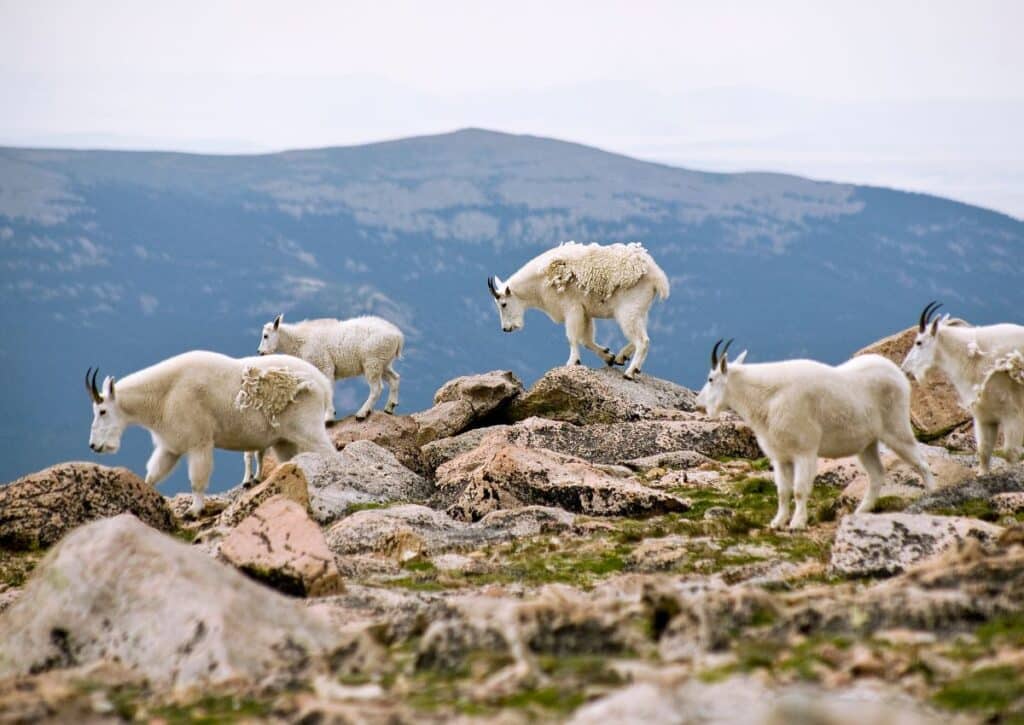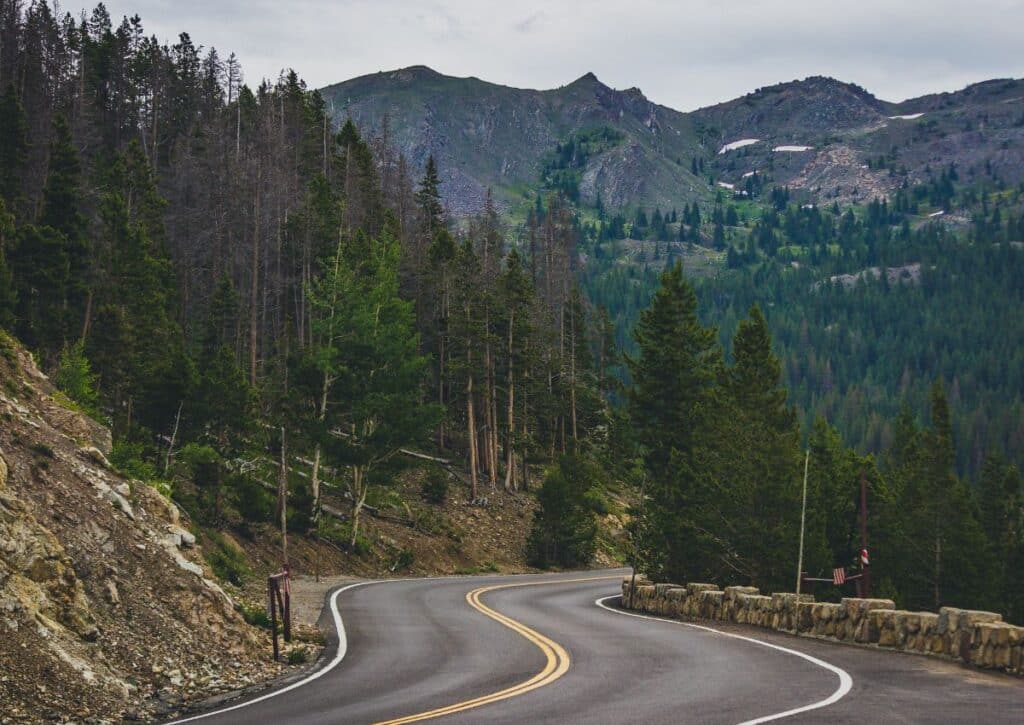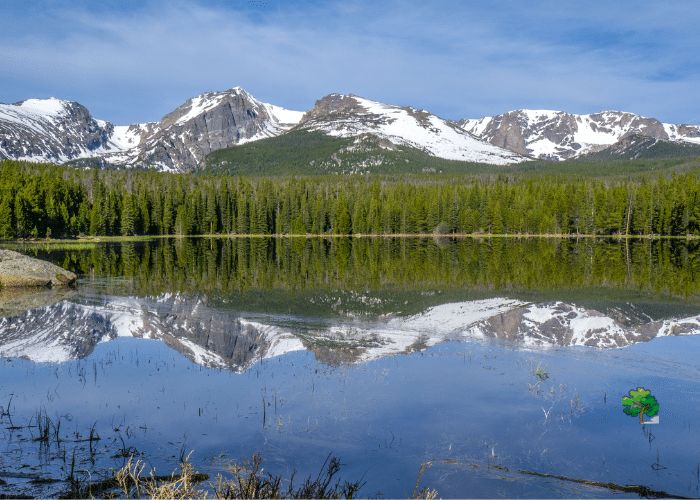Explore 29 animals in the Rocky Mountains we've seen after hiking here for 2 decades! With tips and stunning photographs!
Pack your binoculars and lace-up those hiking boots because the Rocky Mountains are more than just a scenic backdrop for your trail mix breaks—they’re a bustling highway of wildlife!
This isn’t just walking with a view; it’s a wild adventure where every turn on the trail could have you coming nose-to-snout with the furry locals.
Imagine ambling along only to spot a moose nonchalantly munching on willows or witnessing the cheeky flash of a pika’s ears as it scampers away. Each path you choose is like rolling the dice in a game of wildlife bingo, and knowing the right spots is your cheat sheet to hitting the jackpot.
But hey, don’t forget to look up and down! The sky is a stage for feathered aces, and the ground beneath is a whole other universe, crawling and hopping with creatures that might not make the front page of a nature magazine but definitely deserve a snapshot.
So, if you’re ready to exchange nods with the wild residents of the Rocky Mountains, strap on your pack—it’s not just a hike, it’s a full-on quest for an up-close peek into Mother Nature’s most cherished secrets.
Habitats in the Rocky Mountains to See Wildlife
The Rocky Mountains, a vast mountain range stretching over 3,000 miles across North America, offer a diverse array of habitats that cater to an extensive variety of flora and fauna.
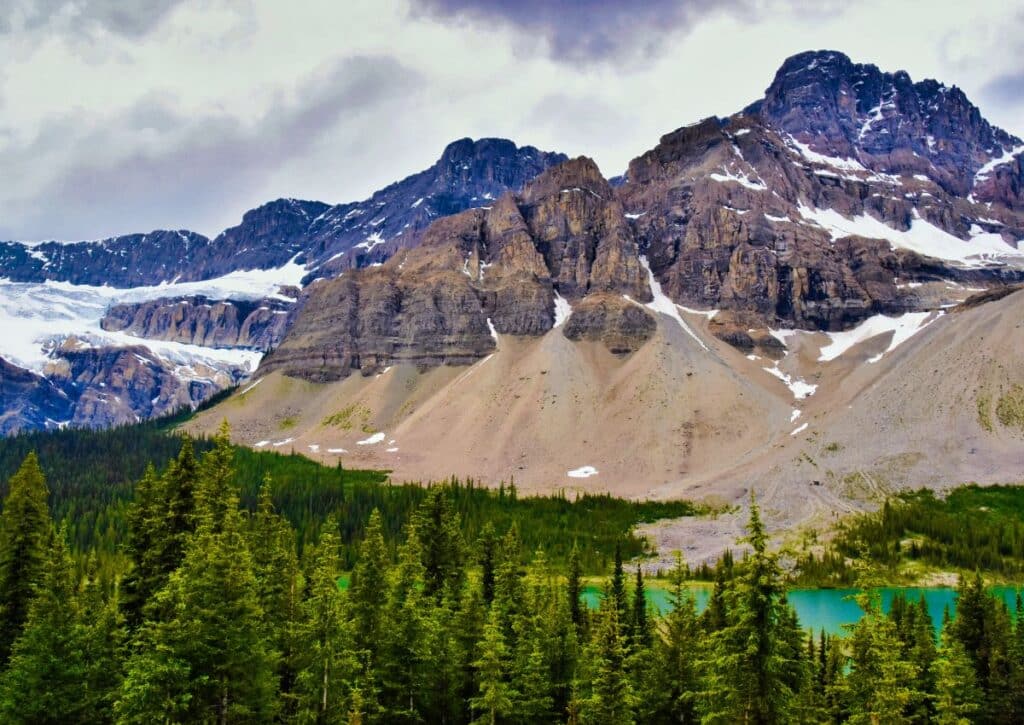
Alpine Tundra: Above the treeline, the alpine tundra reigns, characterized by its low temperatures, high winds, and a short growing season.
Despite the harsh conditions, this habitat supports specialized flora like cushion plants and fauna like pikas and ptarmigans, all adapted to the cold.
For those seeking this high-altitude experience, Trail Ridge Road offers panoramic views and tundra exploration opportunities.
Subalpine Forests: Just below the tundra lies the subalpine zone. This habitat features dense forests of spruce, fir, and lodgepole pines.
The cold climate and higher elevations here make it a refuge for species like snowshoe hares and lynx.
The Emerald Lake Trail traverses through this zone, presenting hikers with pristine lakes and dense woodlands.
Montane Forests: Descending further, the montane forests emerge.
These forests, primarily made up of ponderosa pines, Douglas firs, and aspens, offer shelter and food for a plethora of animals.
With elk and black bears roaming these parts, the Deer Mountain Trail offers a delightful montane trek with a rewarding summit view.
Grasslands and Meadows: Interspersed between the forested areas, are the park’s grasslands and meadows.
These areas are rich in wildflowers and grasses, providing grazing grounds for herbivores like bison and habitats for various birds, including the mountain bluebird.
The Big Meadows via the Green Mountain Trail is an ideal choice for those wanting to wander through these lush landscapes.
Wetlands: Scattered throughout the Rockies are wetlands, vital ecosystems that support unique biodiversity.
These areas are teeming with life, from amphibians like the boreal chorus frog to birds like the American dipper.
A stroll along the Cub Lake Trail might grant encounters with amphibians and the sight of various waterfowl.
Riparian Zones: The regions alongside the rivers and streams of the Rockies are known as riparian zones.
These habitats are lush and support a variety of plants and animals. Beavers, otters, and various fish species can be found in these waters, while the dense vegetation provides shelter for countless birds.
The Moraine Park area, with its intertwining trails, runs along the Big Thompson River, offering glimpses of beavers and otters amidst the vibrant vegetation.
Moose
Majestically towering against the backdrop of the Rocky Mountain National Park, moose stand as one of nature’s grand spectacles. As the largest members of the deer family, their presence is undeniably imposing.
Dark brown fur, iconic shovel-shaped antlers, and a stature that can rise to seven feet at the shoulder make them both captivating and easily distinguishable.
Their unique appearance is complemented by some intriguing behavioral characteristics. While they might seem calm and solitary, moose can be surprisingly agile.
Those long legs, which may at first appear disproportionate, not only allow them to wade effortlessly into ponds and lakes to feed on aquatic plants but also navigate deep snow during winter.
Keen observers and hiking enthusiasts would be delighted to know that the west side of the park, especially the Kawuneeche Valley, is where these magnificent creatures often roam.
Trails like the Colorado River Trail in this region offer the best chances for moose sightings, especially during the tranquil hours of dawn or dusk.
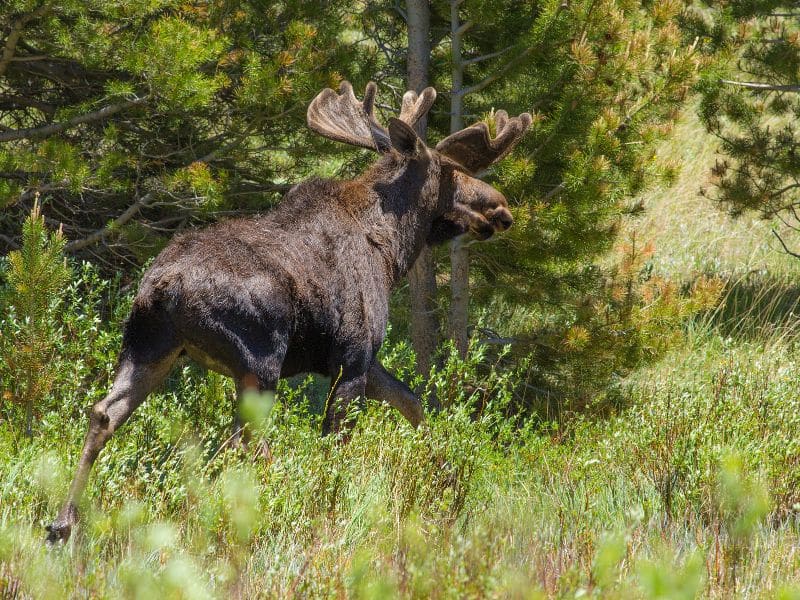
However, an encounter demands respect and caution. Especially during the mating season, moose can be quite territorial.
Female moose, known as cows, are fiercely protective of their calves. It’s essential to maintain a safe distance and avoid startling them.
During warmer days, they can be seen taking refreshing dips, providing them an escape from both heat and bothersome insects.
While their eyesight might only be average, those broad, pendulous ears serve them well, capturing even the softest sounds, be it the rustle of a lurking predator or the eager steps of a hiker.
Spotting a moose in the wild expanses of the Rocky Mountain National Park is an experience that imprints on memory. Yet, as with all wildlife, it’s a moment best enjoyed from a respectful distance, cherishing the raw beauty and power of nature.
Elk
Elk are among the most prominent mammals found in the Rocky Mountain National Park. With their reddish-brown fur and distinctive beige rump patch, they are easily identifiable amidst the park’s diverse landscapes.
Their sprawling antlers, especially on mature males, are a sight to behold and can span up to four feet.
These herbivores have an intriguing behavioral pattern. They partake in seasonal migrations, moving to higher altitudes in the summer to escape the heat and seeking lower valleys during the colder winter months.
This migration pattern ensures they’re consistently in areas with ample food sources.
For hikers and wildlife enthusiasts, the meadows of the park are prime elk-watching territory. Trails such as Moraine Park and Horseshoe Park provide ample opportunities for elk sightings, particularly during early mornings and late afternoons when they are most active.
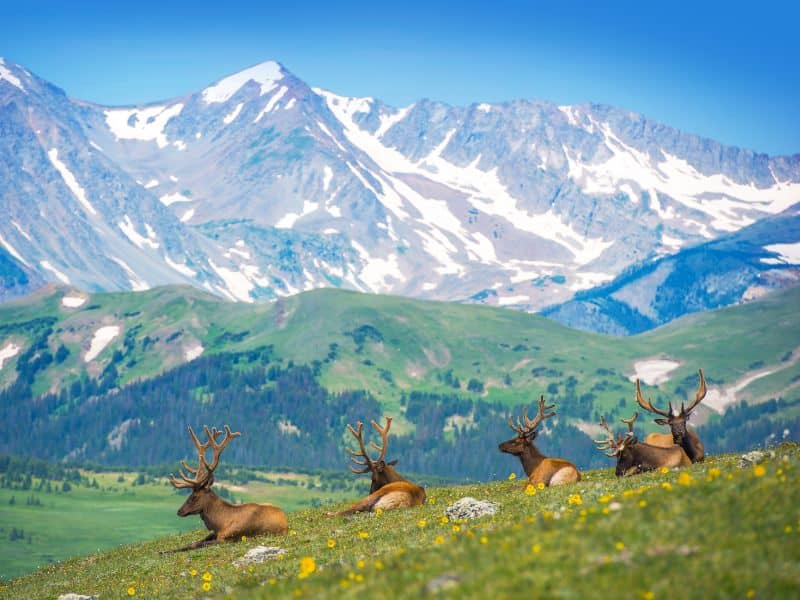
During the fall, one can witness the fascinating elk rutting season. Males engage in vocal calls, known as bugling, to attract females and ward off potential rivals.
This haunting and echoing call adds an audio dimension to the park’s natural wonders.
Though they might appear docile, it’s essential for visitors to exercise caution. Elks can be protective, especially females guarding their calves. Always observe from a safe distance.
Beyond their captivating presence in the Rockies, elk play a pivotal role in the ecosystem, influencing plant distribution and providing prey for predators like mountain lions and wolves.
Pika
Smaller in size but no less captivating, pikas are often referred to as the “rock rabbits” of the Rocky Mountains. Sporting round bodies, short limbs, and large ears, their appearance is undeniably adorable.
Their fur, a mix of brown and gray, provides them with essential camouflage amidst the rocky terrains they call home.
Unlike many alpine animals, pikas do not hibernate. Instead, they gather and store a sizeable “haypile” of plants during the warmer months, which they then consume throughout the cold winter.
This behavior of actively collecting and storing food is a testament to their hardworking nature.
Their preferred habitats are rocky talus slopes and alpine meadows, where they can easily dart between rocks to avoid predators.
Trails that wind through these terrains, like the Alpine Ridge Trail, are potential spots to see or, more likely, hear them. Their high-pitched alarm calls are distinctive and often echo through the mountainsides.
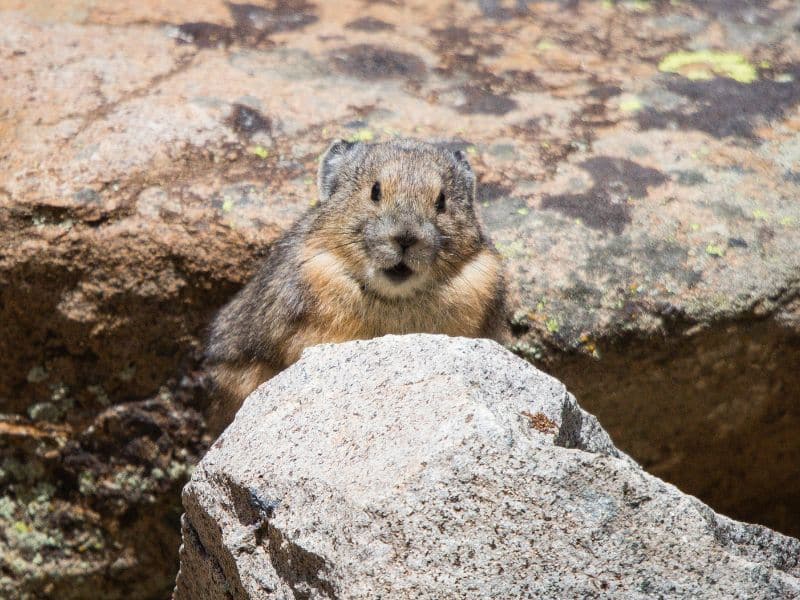
Pikas have become a subject of scientific interest due to their sensitivity to climate change. As temperature-sensitive creatures, they are often considered indicators of changing climate patterns in alpine regions.
Their social behavior is intriguing. Pikas are known to use vocalizations to communicate, from warning off intruders to attracting potential mates.
Spotting a pika might require a keen eye and a bit of patience, but the reward of seeing this charismatic alpine dweller in its natural habitat is well worth the effort.
Just like with larger wildlife, ensuring minimal disturbance to their habitat and routines is crucial for their conservation.
Mule Deer
Mule deer are a familiar sight for many visitors to the Rocky Mountain National Park. Their name derives from their large, mule-like ears, which stand in contrast to their otherwise delicate features.
With a grayish-brown coat in the winter that transitions to a reddish-brown in the summer, these deer have a distinctive appearance that differentiates them from their white-tailed counterparts.
One of the interesting behaviors of the mule deer is their unique bounding gait, known as ‘stotting,’ where all four feet push off the ground simultaneously.
This movement pattern allows them to navigate the rugged terrains of the park with ease and escape potential threats.
For those hoping to spot mule deer, the open meadows and forest edges of the park are your best bet.
Trails like Deer Mountain and Upper Beaver Meadows are aptly named, hinting at the likelihood of deer sightings in these regions, especially during the crepuscular hours of dawn and dusk.
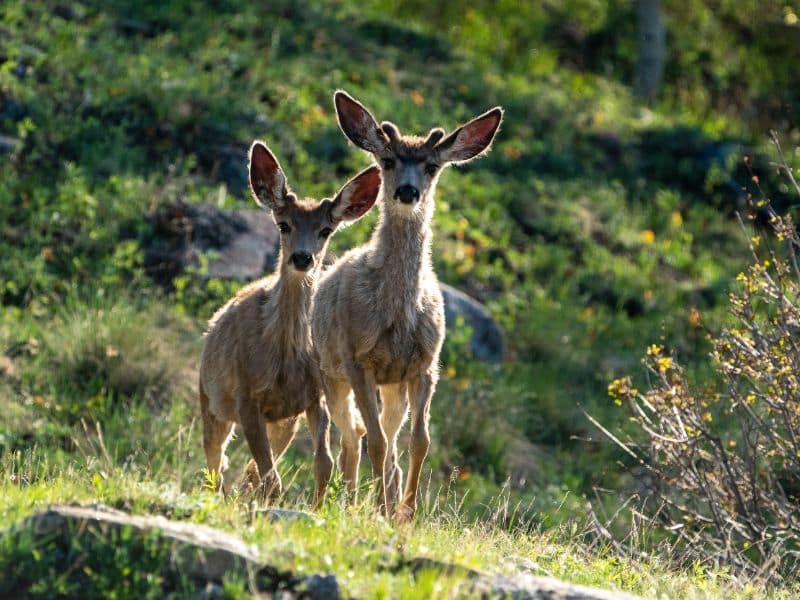
Their diet primarily consists of shrubs, grasses, and forbs. While they might seem unperturbed by human presence, it’s always advised to observe from a distance, ensuring they continue their natural behaviors without disturbance.
An interesting fact: mule deer antlers grow in a bifurcated manner, meaning they fork as they grow, giving mature bucks a majestic and intricate crown.
In the broader ecosystem, mule deer provide an essential food source for the park’s predators, like mountain lions and coyotes. Their presence, behavior, and migration patterns also influence vegetation growth and distribution.
Black Bears
The elusive black bear is an integral part of the Rocky Mountain ecosystem. Although named “black” bears, their fur can vary from jet black to brown, and occasionally even cinnamon or blonde.
Their strong, muscular build, coupled with an acute sense of smell, makes them one of the most adaptable mammals of the park.
Unlike the more aggressive grizzly bear, which is not found in the park, black bears are generally more reclusive.
They are omnivores with a diet consisting of berries, nuts, insects, fish, and occasionally, small mammals. In preparation for hibernation, they enter a phase called hyperphagia during fall, voraciously eating to build fat reserves.
For those seeking a glimpse of these magnificent creatures, the forested areas of the park are prime territories. Trails such as Gem Lake and Cub Lake traverse through habitats frequented by black bears.
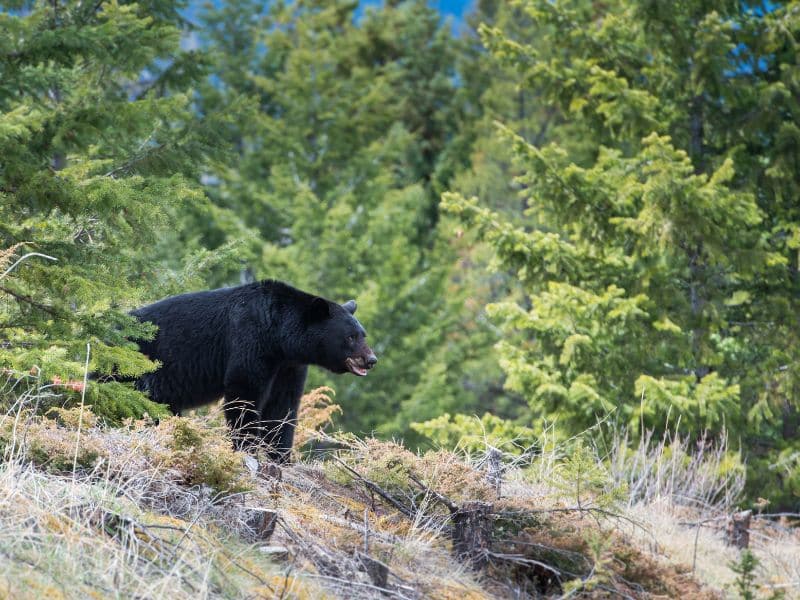
It’s vital, however, to practice bear safety: store food properly, make noise while hiking, and carry bear spray.
During winter, black bears go into hibernation, often in dens they’ve carved into hillsides or under tree roots. Here, they can remain for up to 7 months without eating, drinking, or excreting.
The presence of cubs alongside a female bear demands utmost caution. While they might appear adorable and harmless, a protective mother bear is not a force to be reckoned with. Always ensure a safe distance.
Black bears play a pivotal role in the park’s ecology. By dispersing seeds through their droppings, they aid in vegetation growth. Their foraging behavior also keeps certain insect populations in check.
Mountain Lion
Mountain lions, also known as cougars or pumas, are the stealthy apex predators of the Rocky Mountain National Park. They boast a sleek, muscular body covered in a tawny coat, allowing them to seamlessly blend into their surroundings.
Their powerful hind legs, longer than the front, enable them to make incredible leaps and bounds while chasing prey or navigating rugged terrains.
Their solitary and nocturnal nature means that they are rarely spotted by visitors. However, signs of their presence, such as scat or tracks, are occasionally encountered on the park’s trails.
Predominantly carnivorous, their diet mainly consists of deer, though they won’t shy away from smaller mammals when the opportunity presents itself.
For those hoping to understand the habitats of this elusive cat, the more remote and rugged regions of the park are their domain. Trails like Wild Basin and Black Canyon traverse through territories frequented by mountain lions.
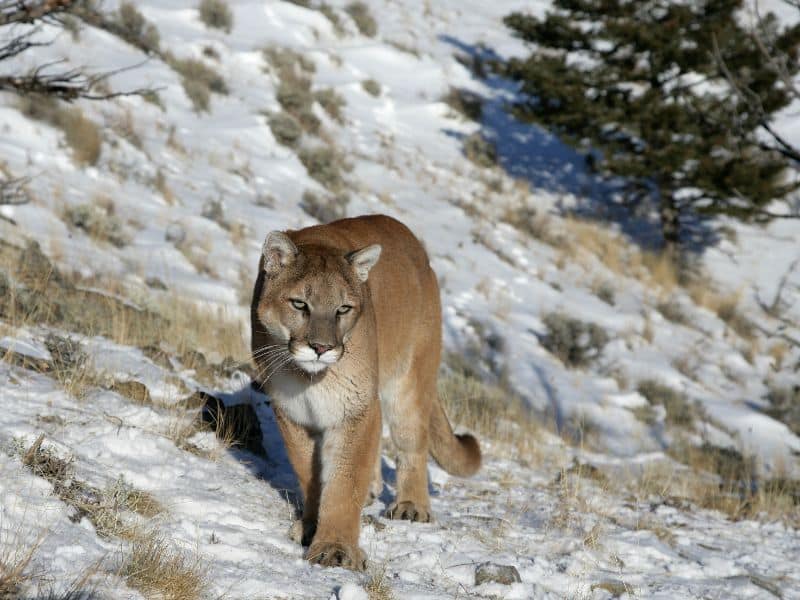
However, seeing one is a rare and memorable experience. Hikers should be aware and practice safety measures, such as hiking in groups and keeping a watchful eye on small children.
Mountain lions have an incredible territorial range, often spanning hundreds of square miles. This vast range is marked and patrolled regularly, with males being particularly protective against other intruding males.
While encounters are rare, it’s vital to know how to react if one crosses paths with a mountain lion. Standing tall, making noise, and avoiding direct eye contact are some measures to deter any potential aggressive behavior.
Mountain lions play a crucial role in the park’s ecosystem by regulating the population of herbivores, thus ensuring a balance that allows vegetation to flourish.
Yellow-bellied Marmot
With their chunky bodies, expressive faces, and distinctive yellowish-brown underbelly, yellow-bellied marmots are one of the charismatic mammals of the Rocky Mountain National Park.
These ground-dwelling rodents are often seen sunbathing on rocks or alertly surveying their surroundings from a vantage point.
Marmots live in colonies and create burrow systems where they take refuge from predators and retreat during the harsh winter months. Their primary diet consists of greens and flowers, making the alpine meadows their preferred foraging grounds.
Hikers exploring the park’s high-altitude regions, such as the Tundra Communities Trail or around Trail Ridge Road, are likely to encounter these curious creatures. Their distinctive whistles, an alarm call, can often be heard echoing across the meadows, signaling a potential threat.
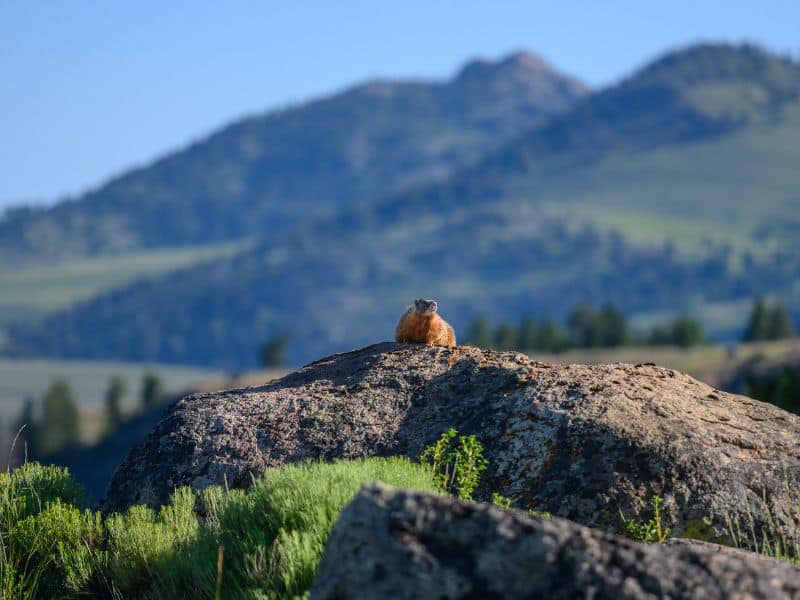
A unique aspect of the yellow-bellied marmot’s life is its hibernation pattern. They spend more than half the year—around 8 months—in deep hibernation in their burrows, living off their fat reserves.
Their social interactions are intriguing. Marmots often engage in playful bouts, wrestling, and chasing one another, providing delightful scenes for wildlife enthusiasts. They also communicate through various vocalizations, from warning calls to mating signals.
The role of marmots in the ecosystem extends beyond being prey for predators like eagles or foxes. Their digging habits aerate the soil, promoting nutrient mixing, which in turn benefits plant growth in the region.
Snowshoe Hare
The snowshoe hare is an enchanting creature of the Rockies, aptly named for its large hind feet that act like natural snowshoes, allowing it to move efficiently across snowy terrains.
Its coat undergoes a seasonal transformation — a pure white in winter for camouflage in the snow and a brownish-gray in the warmer months to blend into the forest floor.
These hares are primarily nocturnal and are most active during the twilight hours of dawn and dusk. Their diet consists of a variety of plants, including grasses, ferns, and shrubs, depending on the season.
Trails that weave through dense forests and thickets, such as the Kawuneeche Valley and Endovalley, offer a higher probability of spotting these elusive creatures. Their darting movements and quick reflexes, though, might require a sharp eye from keen wildlife observers.
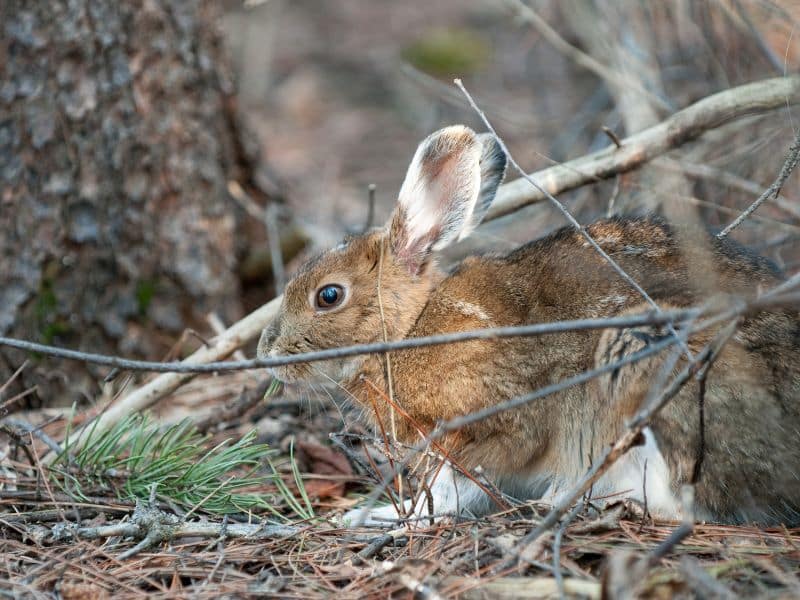
Predators like lynx, owls, and foxes often hunt snowshoe hares. Their boom-and-bust population cycles, which can see dramatic fluctuations, have cascading effects on the park’s predator-prey dynamics.
Rocky Mountain Goat
Regarded as the emblem of alpine environments, the Rocky Mountain Goat is an awe-inspiring sight. With its robust body, stark white coat, and characteristic black horns, this goat is masterfully adapted to the Rockies’ steep and rugged terrains.
Their split hooves provide excellent grip, making their mountainous maneuvers seem effortless.
Preferring the high-altitude, rocky outcrops, and cliffs, these goats can often be seen grazing on grasses, lichens, and mosses. During the summer months, the Ute Trail and areas around Mount Chapin are prime locations for goat sightings.
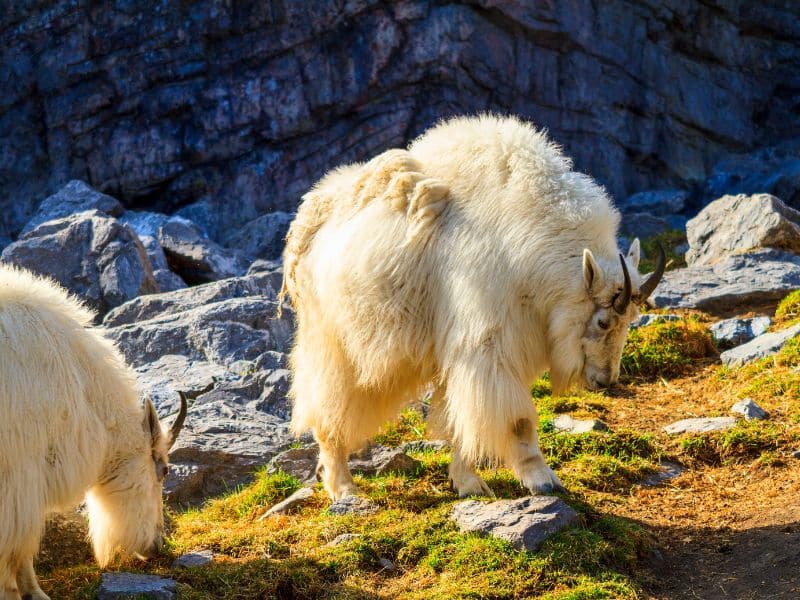
Besides their impressive climbing abilities, these goats are known for their thick, woolly coats that protect them against the harsh alpine elements. Molted fur, shed during the summer, is often repurposed by birds for nest-building.
Though they generally appear calm and poised, it’s crucial to remember that these are wild animals. Keeping a respectful distance ensures both the safety of visitors and the well-being of the goats.
Coyote
The coyote, with its sharp features, tawny coat, and piercing eyes, is one of the Rockies’ most adaptable predators. Their size is somewhere between that of a fox and a wolf, and their cunning nature is often reflected in indigenous tales and folklore.
Coyotes are opportunistic feeders, preying on anything from small mammals like rodents and rabbits to larger prey such as deer, given the chance. They’re also known to consume fruits, berries, and even insects.
Open meadows and grasslands in the park, such as Moraine Park or Big Thompson River, are often the hunting grounds for these skilled predators. Dawn and dusk, the crepuscular hours, are when they’re most active, either hunting or vocalizing with their iconic howls.
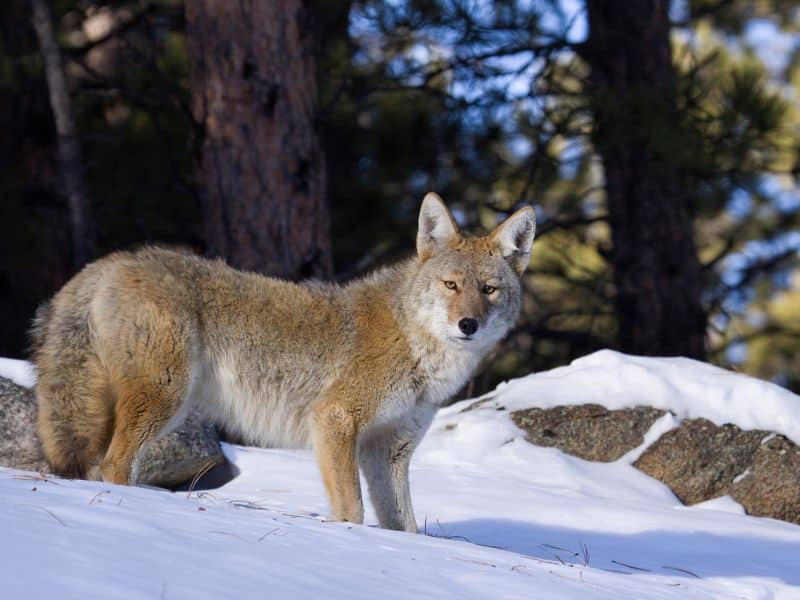
Their adaptability extends to their social structures. While they can hunt in packs for larger prey, it’s also common to see solitary coyotes or those in pairs.
Despite their often vilified reputation, coyotes play a vital role in maintaining ecological balance. By controlling rodent populations and scavenging on carrion, they ensure a healthy turnover in the food web of the Rockies.
Bobcats
Bobcats, named for their short, ‘bobbed’ tails, are among the smaller wild cats of North America and find residence in the diverse habitats of the Rocky Mountain National Park.
With a tawny coat spotted and striped in a manner that aids in camouflage, these cats are nimble predators that move stealthily within their territories.
Their diet is varied, consisting primarily of small mammals like rabbits, hares, and rodents, though they occasionally prey on larger animals when the opportunity arises.
Hikers traversing the woodlands and shrublands, especially around the Big Thompson Valley and Horseshoe Park, might catch a fleeting glimpse of a bobcat, especially during the twilight hours.

The elusive nature of bobcats, combined with their silent demeanor, often makes them a prized sight for wildlife enthusiasts. Their sharp retractable claws and keen sense of hearing make them formidable hunters in their domain.
In the broader ecology of the park, bobcats play a role in keeping rodent populations in check, ensuring a balanced ecosystem.
Least Chipmunk
The smallest of the chipmunk species, the Least Chipmunk, is a sprightly creature often seen darting about the Rocky Mountain National Park.
Recognizable by its alternating dark and light stripes that run down its back, this chipmunk is a bundle of energy and curiosity.
Foraging primarily on seeds, nuts, fruits, and occasionally small insects, they’re often spotted in areas with abundant ground cover and near treelines. The Deer Mountain Trail and Emerald Lake Path are places where one might encounter these nimble rodents.
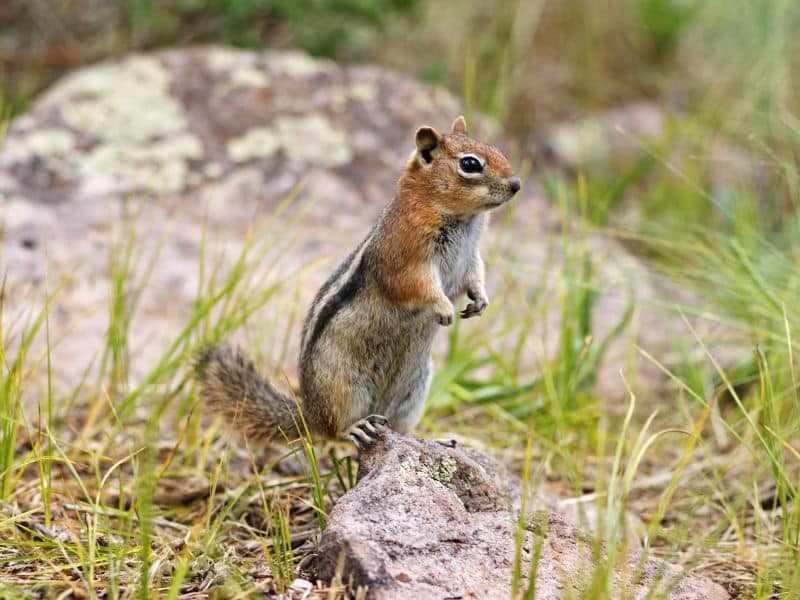
Their cheek pouches, capable of considerable expansion, are used to store food, which they transport back to their burrows for storage. These burrows, often complex in design, serve as shelters and storage units.
Engaging to watch, Least Chipmunks have an array of vocalizations, from high-pitched warning chirps to softer communication calls. Their presence, in turn, offers sustenance for a variety of park predators.
Abert’s Squirrel
With its tufted ears and long bushy tail, the Abert’s Squirrel is an easily distinguishable inhabitant of the Rocky Mountain National Park. They are specially adapted to live in ponderosa pine habitats, which dictate much of their diet and behavior.
Their primary sustenance comes from the ponderosa pines – consuming its seeds, buds, and even the tree’s bark. Consequently, trails surrounded by these pines, like Bierstadt Lake Loop and Pine Ridge, offer the best opportunities for observing these squirrels.
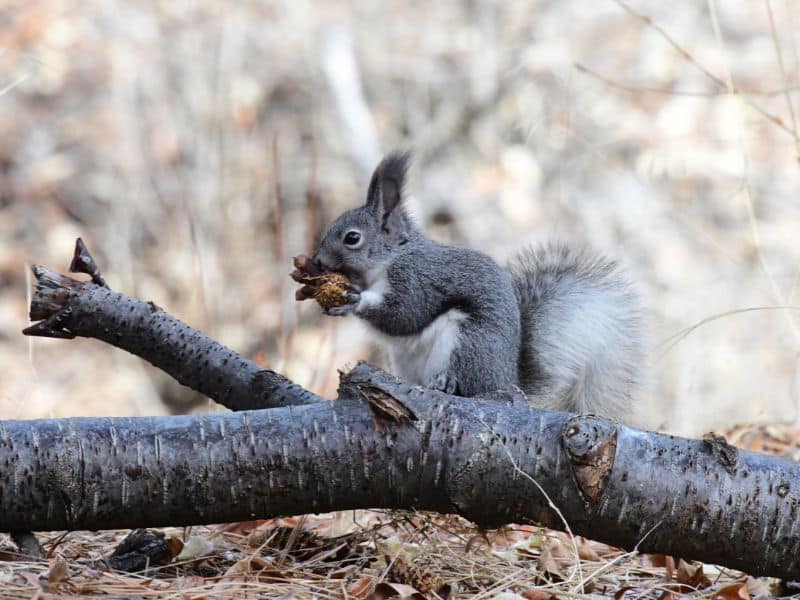
Distinguished by their gray coat and contrasting white underbelly, Abert’s Squirrels are agile climbers and jumpers, often seen leaping between tree branches in search of food or evading predators.
An intriguing behavior of these squirrels is their interaction with pinecones. They strip the cones to reach the nutritious seeds inside, leaving tell-tale piles of stripped cone bracts beneath the trees.
Abert’s Squirrels, being a part of the larger ecosystem, play a role in seed dispersal for the ponderosa pines, ensuring the continuity and health of these vital trees within the park.
American Bison
Majestic and emblematic of the American West, the American Bison is a testament to nature’s grandeur. With its hulking frame, shaggy dark-brown fur, and iconic curved horns, the bison represents strength and resilience.
While not as prevalent in the Rocky Mountain National Park as they once were, bison are occasionally sighted in open meadows and grasslands.
Their diet primarily consists of grasses and sedges, and they’re known for their grazing habits, often seen moving slowly across the plains, methodically consuming vegetation.
Hiking in the lower valleys, especially around the Kawuneeche Valley, offers a possibility, though slight, of spotting these magnificent creatures in the distance.
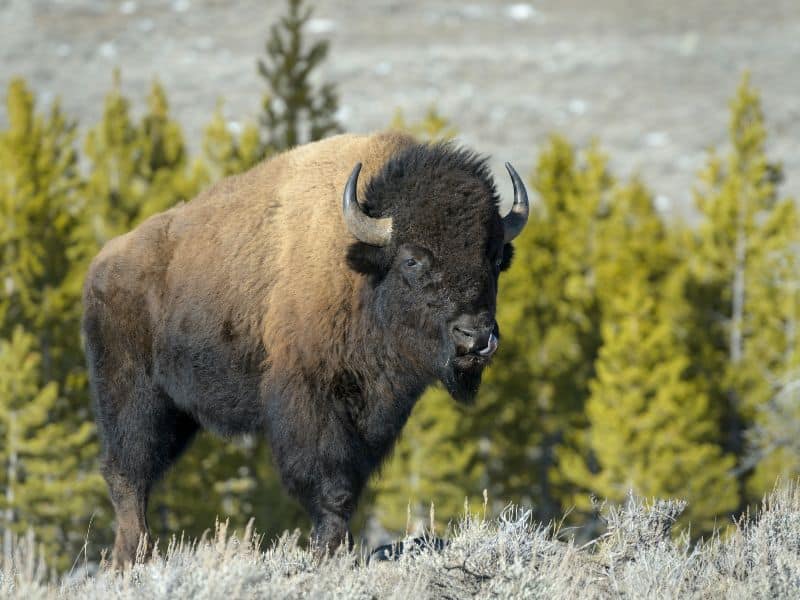
However, it’s more likely to see them in protected reserves or parks specifically dedicated to their conservation.
Historically, bison herds roamed North America in vast numbers, shaping the ecology of the plains. Their wallowing behavior, for example, creates depressions in the land, aiding in water collection and providing mini-habitats for other species.
While the bison’s numbers dwindled tragically in the 19th century due to overhunting and habitat loss, conservation efforts are slowly bolstering their populations.
Their presence, even if peripheral in the Rockies, is a reminder of nature’s endurance and the importance of conservation.
White-tailed Ptarmigan
The White-tailed Ptarmigan, a small ground bird native to the alpine regions of the Rockies, is nature’s master of disguise. With a seasonal plumage that shifts from mottled brown and gray in the summer to pure white in the winter, this bird seamlessly blends with its surroundings, effectively eluding predators.
Primarily herbivorous, the ptarmigan feeds on buds, leaves, and seeds, with its winter diet being largely comprised of willow buds and twigs.
The high-altitude trails like the Flattop Mountain Trail and areas around Tyndall Glacier are the haunts of these elusive birds. Their cryptic coloration, however, means that spotting them requires a keen eye and a bit of patience.
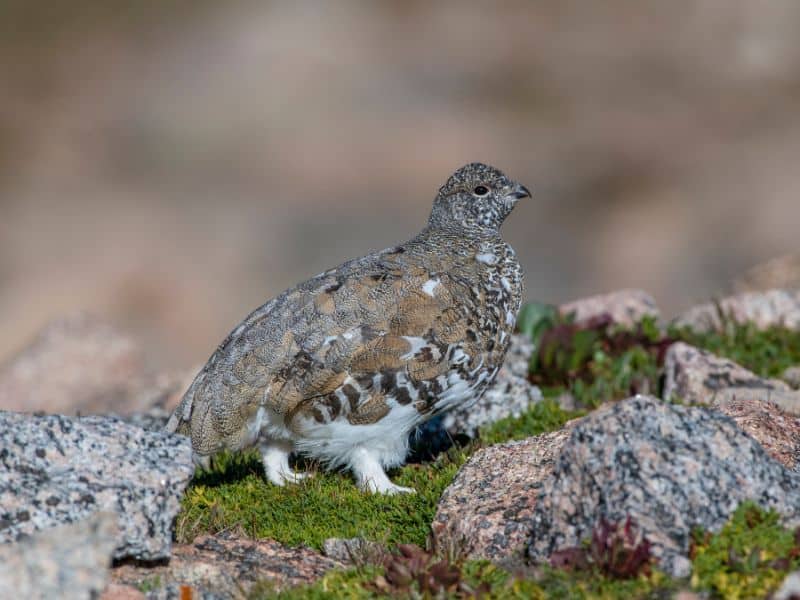
A distinguishing feature of the white-tailed ptarmigan, apart from its plumage, is its feathered feet, which act like natural snowshoes, distributing the bird’s weight and allowing it to walk atop snow without sinking.
Vocal during the breeding season, their calls can sometimes give away their presence before they’re visually detected. Males produce a series of guttural croaks as a display, while females have a high-pitched, repetitive call.
In the grand tapestry of the park’s ecology, the white-tailed ptarmigan, with its unique adaptations, symbolizes the intricate balance and specialization that alpine environments demand of their inhabitants.
American Marten
With its sleek body, sharp features, and luxurious fur, the American Marten is an agile predator of the Rocky Mountains’ forests. This member of the weasel family sports a rich brown coat that contrasts beautifully with its pale-colored throat.
The marten’s large, round ears and curious eyes give it a distinctive appearance.
Dietarily versatile, martens prey on small mammals, like squirrels and chipmunks, and aren’t averse to including birds, insects, and fruits in their meals. Their agility allows them to be adept hunters both on the ground and in the trees.
For those keen on spotting this elusive creature, trails threading through dense, mature forests, such as the Cub Lake Trail or Fern Lake Trail, offer some potential.
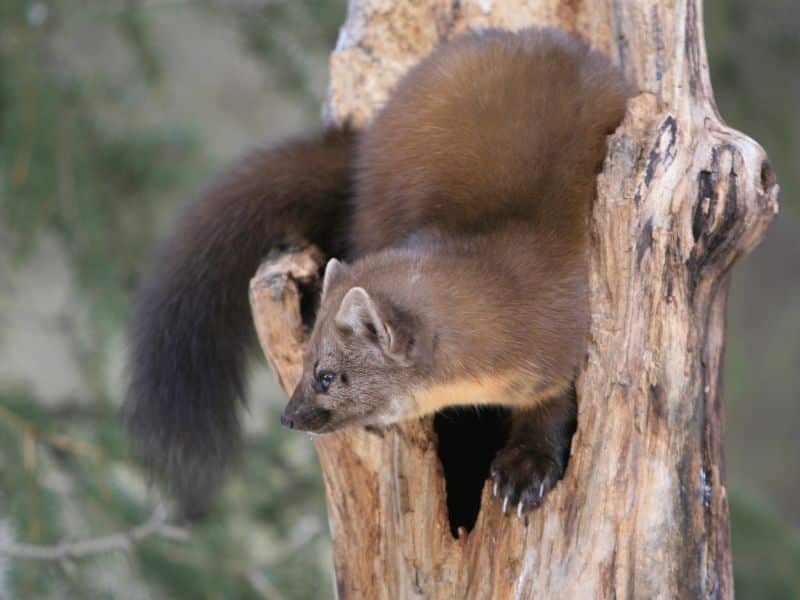
Dusk and dawn, the transitional hours, are when martens are most active.
The marten’s paws, designed for traction, enable them to navigate the icy and snow-covered terrains of the Rockies during the colder months. Despite their small size, they are fierce, known to stand their ground against larger threats.
Serving as both predator and prey in the park’s intricate food web, the American Marten plays a crucial role in maintaining the balance of its ecosystem.
Mountain Bluebird
A fluttering splash of vibrant blue against the Rockies’ rugged backdrop, the Mountain Bluebird is a delightful sight for birdwatchers and hikers alike.
This small, thrush-like bird, with its brilliant azure plumage in males and muted gray-blue in females, embodies the spirit of the high-altitude meadows and open spaces it often inhabits.
Their diet consists mainly of insects, which they often catch in mid-air in swift, acrobatic displays. During colder months, berries become a staple.
For the best chances of a bluebird sighting, the open meadows and burn areas in the park, like Sheep Lakes and Holzwarth Historic Site, are prime locations. These birds are often seen perched on low branches or fence posts, scanning the ground for their next meal.
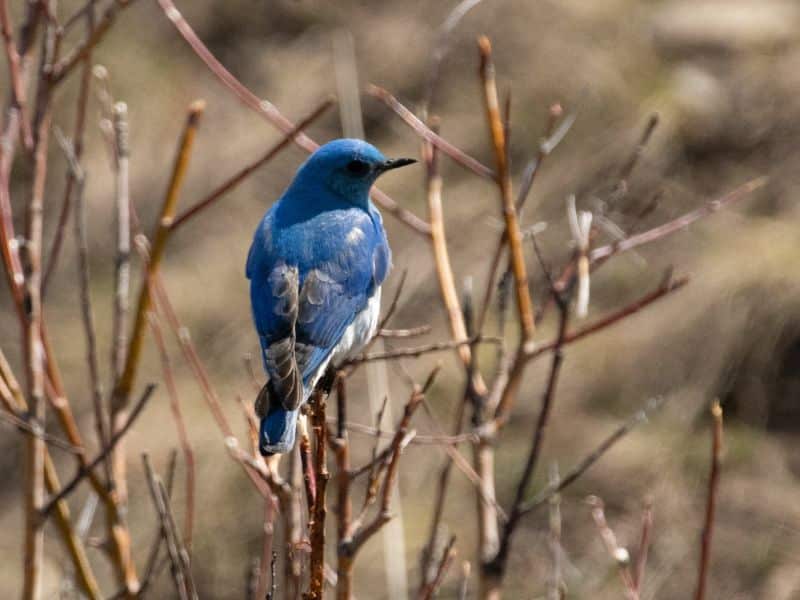
The melodic and clear calls of the Mountain Bluebird, especially during the breeding season, can be a harmonious addition to the ambient sounds of the park.
Apart from their captivating color, these birds play an essential role in controlling insect populations in their habitats. Their presence is indicative of a healthy environment, as they’re sensitive to changes in their ecosystems.
The sight of a Mountain Bluebird in flight, its blue wings contrasting with the green meadows or snowy landscapes, is a poetic testament to the natural beauty housed within the Rocky Mountain National Park.
Red Fox
Amidst the grandeur of the Rockies, the Red Fox stands out with its fiery coat, bushy tail, and characteristic white-tipped tail end. This adaptable carnivore has an omnivorous diet, often foraging on small mammals, birds, fruits, and insects.
The Red Fox’s cunning and intelligence are legendary, demonstrated in its diverse hunting techniques and the ability to survive in a range of habitats. It’s not uncommon to spot them during twilight hours as they are crepuscular by nature.
Trails that skirt the edges of meadows or woodlands, such as the Gem Lake Trail or Moraine Park, can provide hikers with the chance of a fox sighting, especially during dawn or dusk.
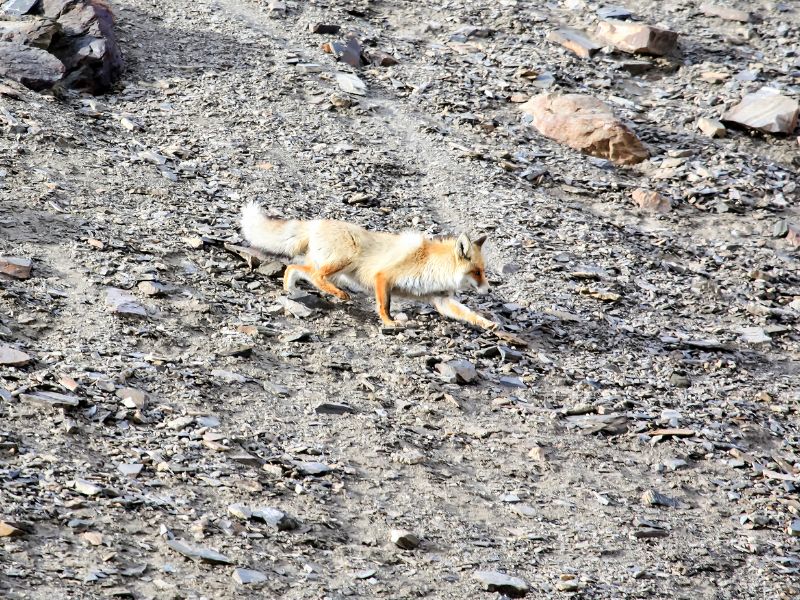
One of the fox’s endearing behaviors is its “mousing” technique, where it leaps high into the air to pounce on unseen prey hidden in tall grass or snow.
Although they tend to be solitary, the vocalizations of a Red Fox, varying from barks to eerie screams, can sometimes pierce the stillness of a mountain night.
Peregrine Falcon
Soaring high above the cliffs and crags of the Rocky Mountain National Park is the Peregrine Falcon, renowned as the fastest bird in the world.
With its sharp beak, dark eyes, and a contrasting pattern of dark and light feathers, this raptor is both a formidable hunter and an awe-inspiring sight.
These falcons primarily prey on other birds, employing a spectacular hunting technique that involves diving from great heights to strike prey mid-air, reaching speeds of up to 240 mph.
A great location to observe these birds would be at the steep cliffs around Lumpy Ridge or Trail Ridge Road, where they often nest and hunt.
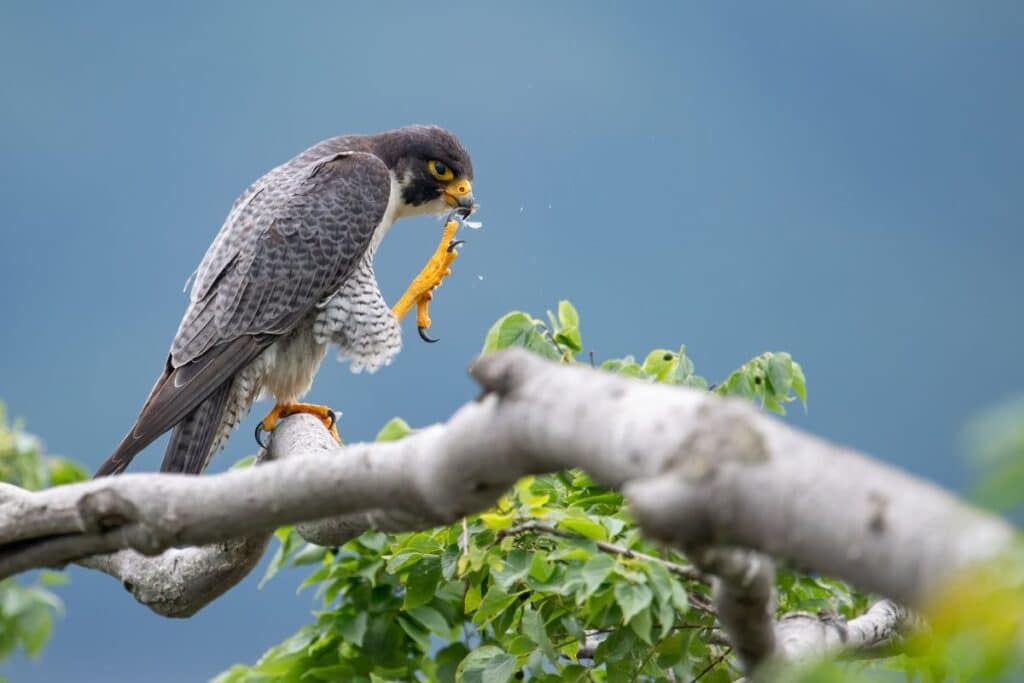
The Peregrine Falcon’s recovery story is one of conservation success. Once severely endangered due to pesticide poisoning, their numbers have rebounded thanks to concerted conservation efforts.
Their distinctive “kek-kek-kek” call can often be heard as they communicate or defend their territories. Their presence in the park is a testament to the resilience of nature when humans intervene positively.
Clark’s Nutcracker
With a sharp bill and a striking black, white, and gray plumage, the Clark’s Nutcracker is an integral member of the Rocky Mountains’ avian community. Often seen flitting about the coniferous forests, this bird has a special relationship with the pine trees it frequents.
Primarily feeding on pine seeds, the Clark’s Nutcracker is known for its incredible memory, storing thousands of seeds in caches and retrieving them months later.
This behavior plays a significant role in forest regeneration, as many of the seeds they hide germinate into new trees.
Hikers exploring areas rich in pines, such as the Bear Lake Trailhead or Longs Peak Trail, might encounter this industrious bird going about its caching activities.
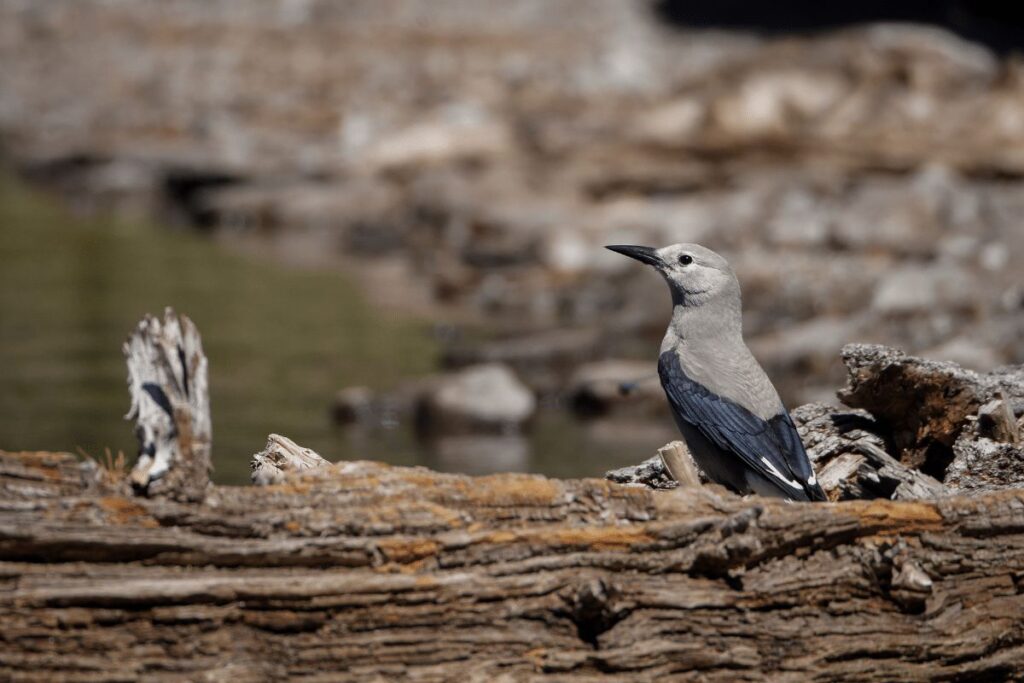
Their vocal nature makes them easy to detect, often producing a variety of calls that resonate through their woodland homes.
Apart from their ecological importance, Clark’s Nutcrackers also have historical significance. They were named in honor of William Clark, of the Lewis and Clark expedition, highlighting their longstanding association with the American wilderness.
Long-tailed Weasel
With its lithe form, bright eyes, and distinctive long tail, the Long-tailed Weasel stands out as one of the most animated hunters in the Rockies.
Its fur transitions from a rich brown with white underparts in warmer months to an almost entirely snowy white in winter, leaving just a black-tipped tail as a striking contrast.
Always on the move, this carnivore primarily targets rodents but has been known to tackle prey larger than itself, showcasing its fearless nature. Their sharp, keen senses aid in locating prey whether burrowed in the ground or camouflaged in snow.
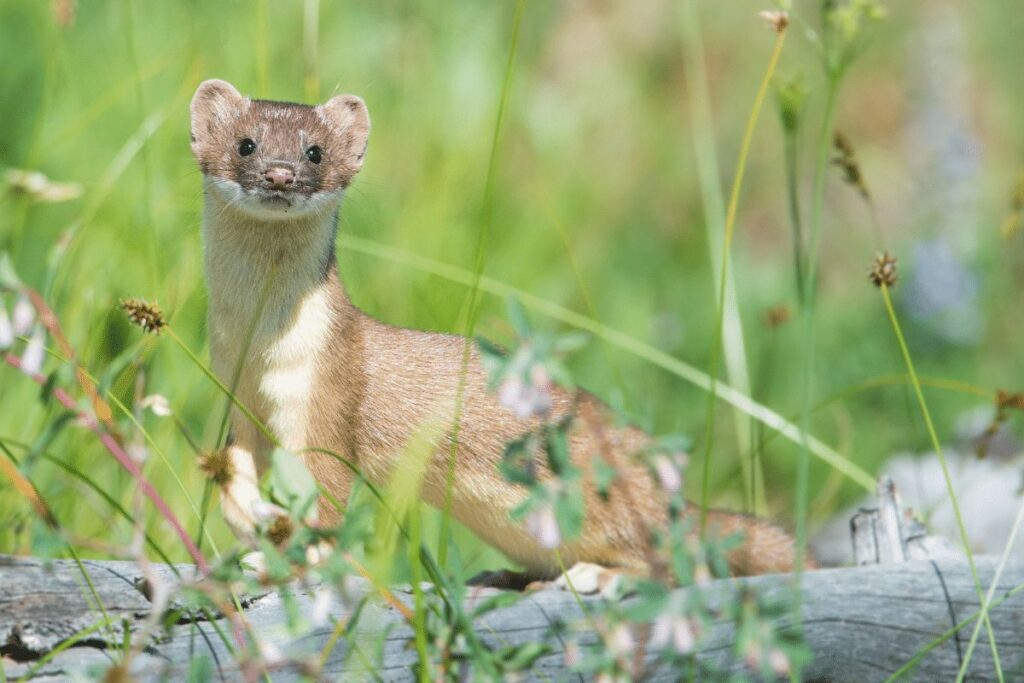
In the expansive Rocky Mountain National Park, areas with a combination of meadows and forest edges like Deer Mountain Trail or Green Mountain Trail are places where the keen-eyed hiker might spot this creature.
A sight of this weasel is often fleeting; their rapid, bounding movements coupled with their acute awareness make them both a captivating and challenging animal to observe.
Three-toed Woodpecker
With its rhythmic tapping resonating through the forests of the Rocky Mountains, the Three-toed Woodpecker is a sentinel of the coniferous wilderness. Displaying a mix of black, white, and a dash of yellow (in males), its presence is both seen and heard.
It’s a master at extracting insects, particularly the larvae of bark beetles, from the bark of trees. This diet not only sustains the woodpecker but also controls potential pest outbreaks, underlining its ecological significance.
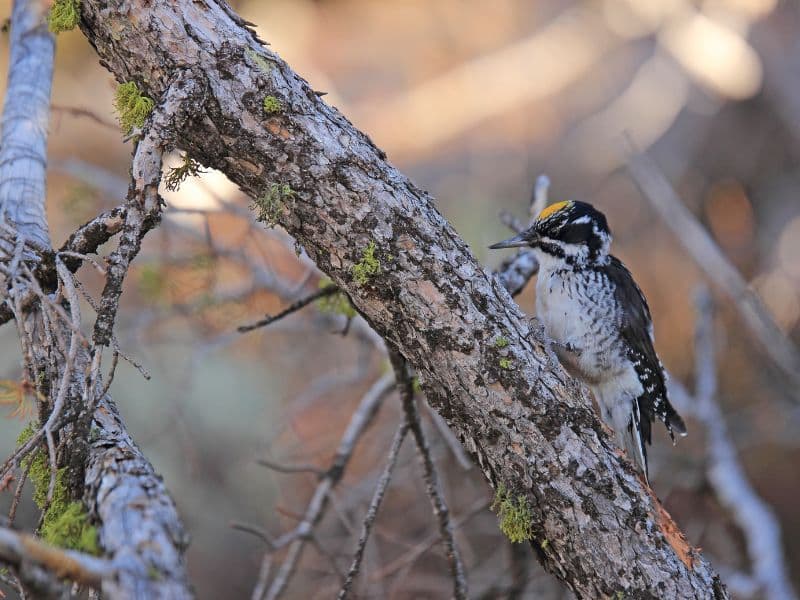
Places with dense coniferous woods, like the pathways around Bear Lake or Dream Lake, offer promising locales for those hoping to catch a glimpse or hear the signature percussion of this bird.
Interestingly, post-forest fire regions are a haven for the Three-toed Woodpecker, where they capitalize on the influx of wood-boring insects that such events usher in.
American Dipper
At the convergence of air and water in the rocky streams of the park, the American Dipper showcases its remarkable adaptability. This stout, gray bird, often seen bobbing on rocks in midstream, is a master diver, plunging into icy waters in search of aquatic insects.
Using its wings to propel itself, it ‘flies’ underwater, navigating the currents with an agility that belies its modest appearance. Its eyes are equipped with nictitating membranes, clear third eyelids that allow it to see underwater.
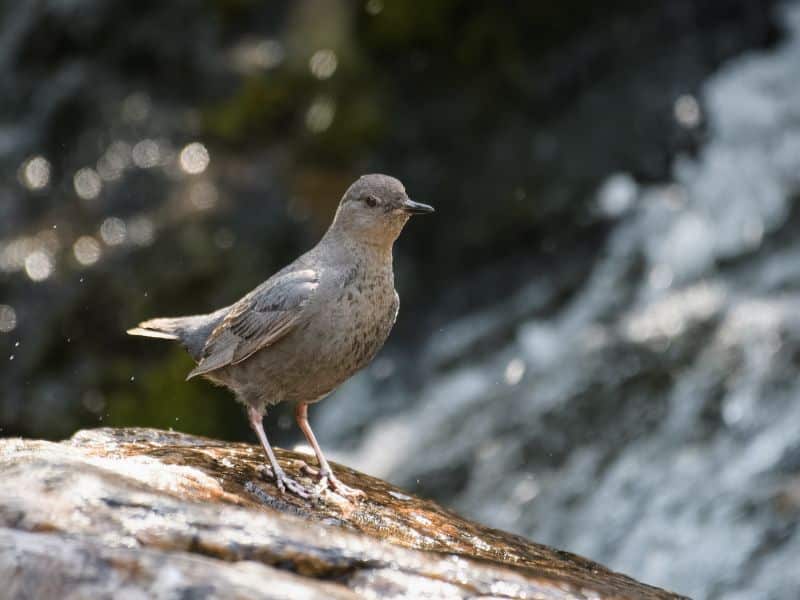
The fast-flowing streams of Wild Basin or cascades near Ouzel Falls provide ideal habitats and excellent viewing opportunities for those on the lookout for the dipper.
Uniquely, the American Dipper’s song – a series of high, clear notes – adds a melodious backdrop to the sounds of bubbling streams and rushing waterfalls in the park, making it a memorable presence in its aquatic realm.
Golden Eagle
Majestic and awe-inspiring, the Golden Eagle reigns supreme in the skies of the Rocky Mountains. With a wingspan that can reach up to 7 feet, it’s easily distinguished by its dark brown plumage with lighter golden-brown feathers on its head and neck.
These eagles favor open or semi-open country, and their keen eyesight is unparalleled, allowing them to spot prey from great distances.
They primarily hunt mammals like rabbits, ground squirrels, and marmots, soaring in the thermals and then stooping rapidly to seize their quarry.
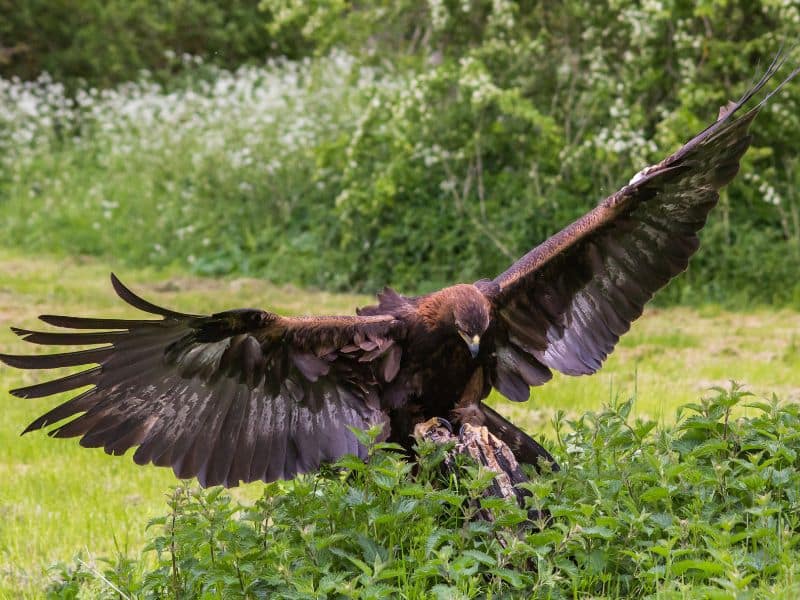
Hikers and wildlife enthusiasts exploring higher elevations, especially around Trail Ridge Road or Ute Crossing Trail, can occasionally be treated to the sight of a Golden Eagle scanning the terrain below or engaging in breathtaking aerial displays.
Apart from their hunting prowess, these eagles are known for their intricate courtship rituals which include a series of high-speed aerial maneuvers. Witnessing such a display is truly a memorable experience.
Their nests, usually located on cliff faces or in tall trees, can be enormous structures used year after year. They underline the eagle’s commitment to their territory and mate, as these magnificent birds often form lifelong pair bonds.
Broad-tailed Hummingbird
A flash of iridescent green and a characteristic trilling sound herald the presence of the Broad-tailed Hummingbird in the Rocky Mountains. Females are green above with a white belly, while males boast a brilliant ruby-red throat.
One of the most captivating sights in the park is watching these hummingbirds hover in mid-air, wings a blur, as they extract nectar from flowers with their specialized long bills. They play a crucial role in pollination, ensuring the continued bloom of many native flowers.
The meadows filled with wildflowers around Cub Lake or the pathways of Emerald Lake Trail are prime spots to observe these agile fliers, especially during the warmer months when flowers are in full bloom.
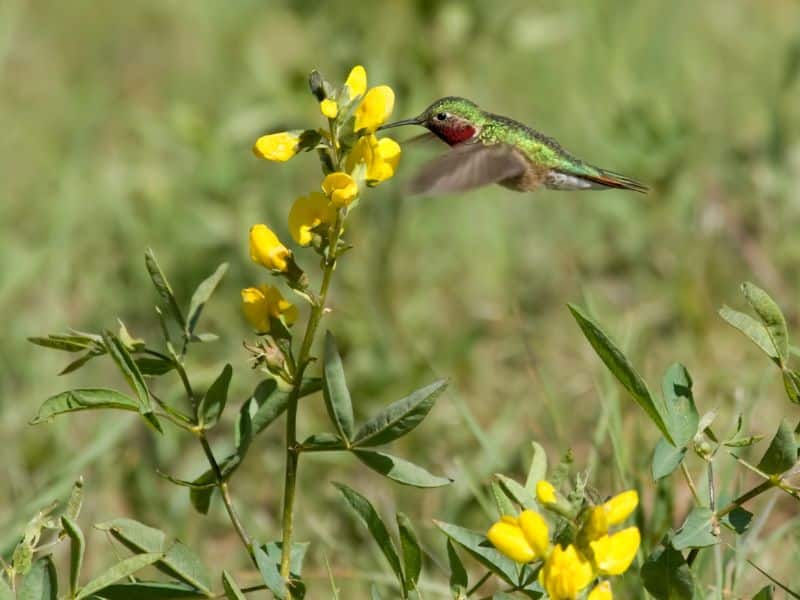
Broad-tailed Hummingbirds migrate impressive distances, traveling between the Rocky Mountains and Central America. Their return to the Rockies is timed perfectly with the blossoming of spring flowers.
Interestingly, at high elevations where nights can be particularly cold, these hummingbirds can enter a state of torpor, slowing their metabolic rate to conserve energy. By morning, they’re back to their energetic selves, darting from flower to flower.
White-crowned Sparrow
The crisp black-and-white striped crown of the White-crowned Sparrow makes it a distinctive sight against the backdrop of the Rocky Mountain meadows and woodlands. Their soft, melodic songs add a soothing soundtrack to hikes throughout the park.
These sparrows are primarily ground feeders, often seen hopping about or scratching the ground in search of seeds. They do, however, have a varied diet that includes insects, especially during the breeding season.
Places like Moraine Park or the grassy areas around Estes Park can offer delightful sightings of these sparrows, particularly during the early mornings or late afternoons when they are most active.
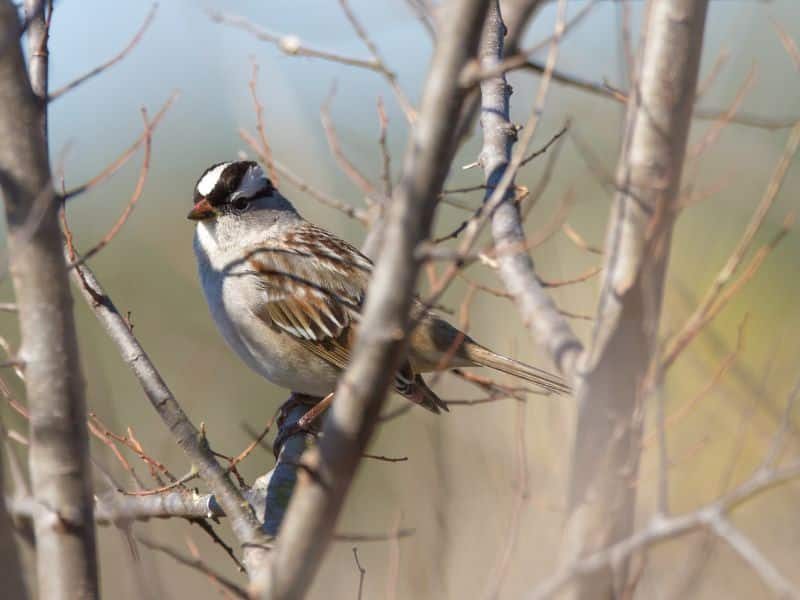
Each individual bird’s song is a variation on a shared theme, and interestingly, young sparrows learn their tunes by listening to the adults in their vicinity. This results in regional “dialects” where groups of sparrows in different areas have subtly different songs.
While they breed in the northern parts of North America, the Rockies become a vital stopover for many during migration. Observing the White-crowned Sparrow, with its iconic head markings and sweet song, adds a layer of joy to any hike in the park.
Mountain Chickadee
The black cap and distinctive white stripe through the eyes make the Mountain Chickadee an unmistakable resident of the Rocky Mountains. Their cheery “chick-a-dee-dee-dee” calls echo through the coniferous forests, acting as nature’s own soundtrack for hikers.
Their agile movements can be observed as they flit from branch to branch, often hanging upside-down to glean insects from bark crevices or pick at seeds. The Gem Lake Trail and the pine-rich surroundings of Bear Lake are just a few places where these birds are active.
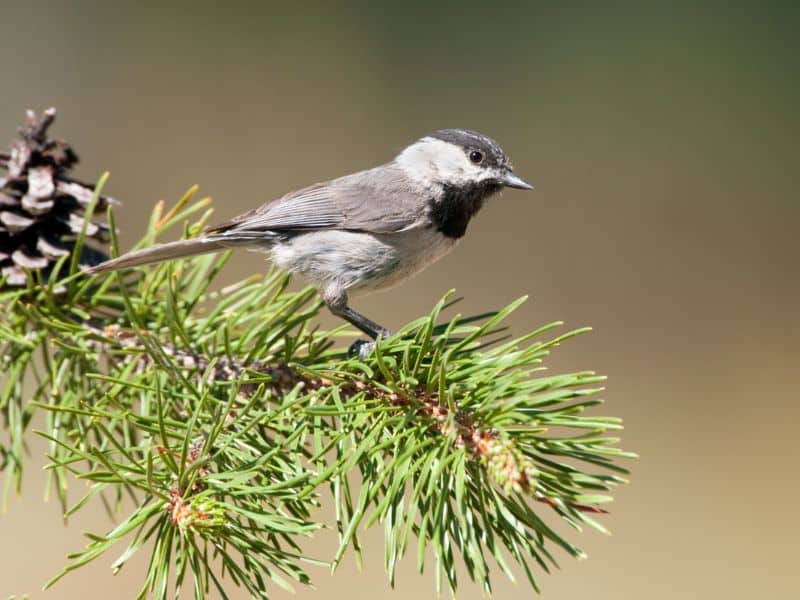
Winter doesn’t deter them. With their incredible ability to remember the locations of hundreds of seeds they’ve hidden, these chickadees thrive, even in the coldest months.
Interestingly, the black and white patterns on their heads are more than just for show. Studies suggest that they may play a role in communication and mate selection among these petite birds.
Black-footed Ferret
A symbol of conservation success in North America, the Black-footed Ferret, with its sleek body and distinctive face mask, is a rare and special sight in the wild terrains of the Rocky Mountains. Historically, they were believed to be extinct until a small population was discovered.
Nighttime excursions, especially in prairie dog colonies around the park’s lower elevations, might give wildlife enthusiasts a slim chance of spotting this nocturnal predator. They largely depend on prairie dogs for food, making these colonies their primary hunting grounds.
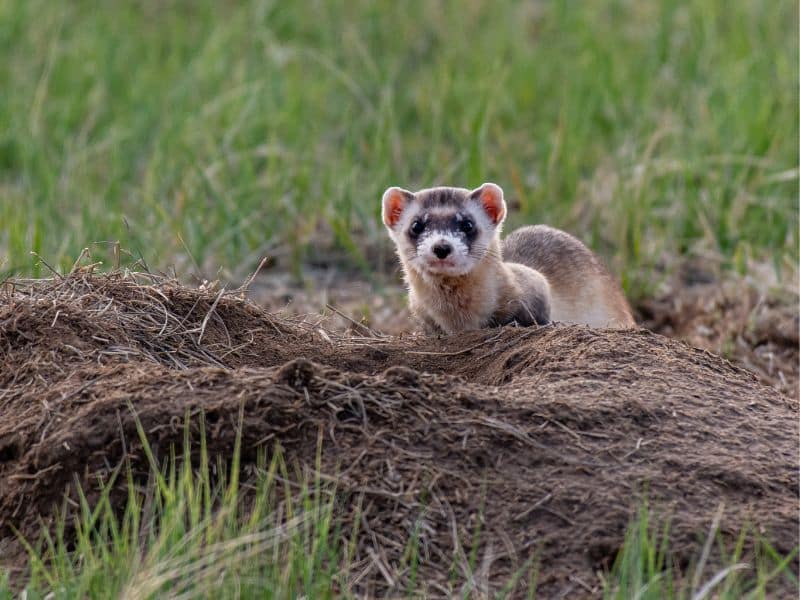
Apart from their primary diet, these ferrets are known for their playful antics. Their curious nature makes them engage in hide and seek or mock fights with their peers.
A unique adaptation they possess is the ability to mimic the calls of their prey, luring them out and turning the tables on unsuspecting victims.
Pronghorn
The image of a Pronghorn sprinting across the vast meadows of the Rockies is a sight to behold. Often mistakenly called antelope, Pronghorns are unique to North America and are famed as the continent’s fastest land animals.
Their tan bodies with contrasting white underbellies and markings make them easily distinguishable. The curved, black-tipped prongs on their heads give them their name.
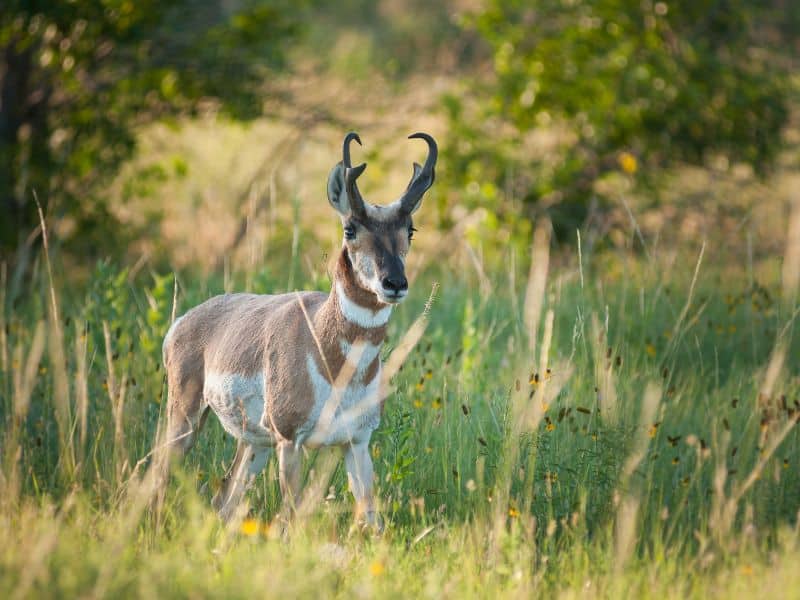
Areas of open terrain, like the Kawuneeche Valley, offer the best chances of spotting these graceful runners. In their quest for fresh grazing, they can cover vast distances, often at speeds that leave predators trailing in their wake.
While their speed is legendary, their eyesight is equally impressive. Their large eyes can spot threats from miles away, giving them ample time to decide on flight over fight.
Dark-eyed Junco
Often recognized by their slate-colored bodies and white bellies, the Dark-eyed Juncos are a common sight in the forests and meadows of the Rocky Mountains. Their cheerful, trilling songs often accompany hikers along many trails.
Frequenting the ground, they’re often seen hopping about, scratching the earth to uncover seeds. The woodlands surrounding Endovalley Picnic Area and the paths leading to Adams Falls are spots where these birds are particularly active.
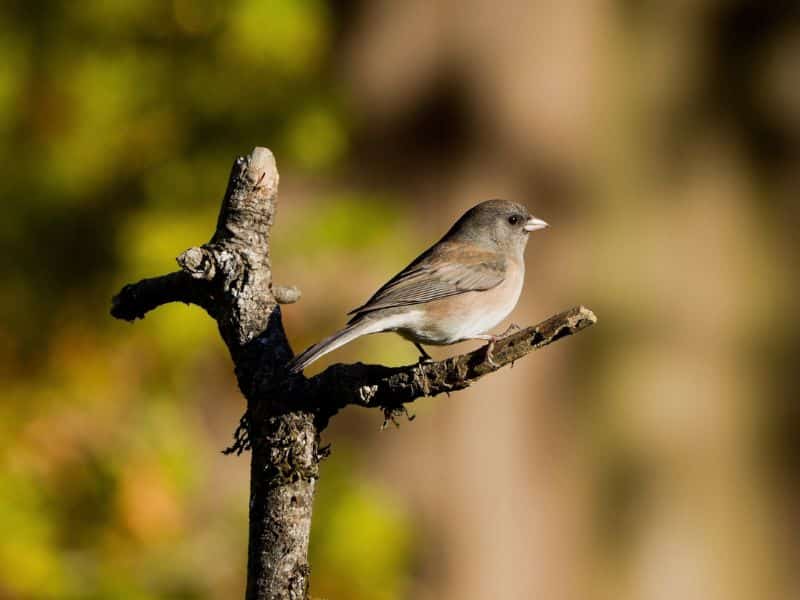
The way they flit and flutter, flashing their white outer tail feathers, is characteristic and is often how many birdwatchers first notice them.
These juncos are migratory, moving to lower elevations or further south during the harshest winter months. Their adaptability to different habitats and diets makes them one of the most widespread and common birds in North America.
10 Tips for Wildlife Viewing in the Rocky Mountains
- Early Bird Gets the View: Many animals are most active during the early morning or late afternoon. Set out during these times to increase your chances of sightings.
- Stay Quiet & Patient: Wildlife can easily be spooked by loud noises. Move quietly, speak softly, and sometimes, just find a spot to sit and wait.
- Use Optics: A good pair of binoculars or a spotting scope can make a big difference, allowing you to observe animals from a safe and non-intrusive distance.
- Know the Habitats: Different animals prefer different habitats. Research where the species you’re interested in are most likely to be found—whether it’s alpine meadows, dense forests, or riparian zones.
- Dress Appropriately: Wear earth-toned or neutral-colored clothing to blend into the environment. This makes you less noticeable to wildlife.
- Safety First: Always maintain a safe distance from animals. No photograph or close-up view is worth disturbing wildlife or putting oneself in danger.
- Tread Lightly: Stick to marked trails to minimize impact on delicate habitats. Remember, your actions can influence the behavior and well-being of the animals.
- Educate Yourself: Read up or attend ranger-led talks about the animals you’re hoping to see. Knowing their behavior can help you spot them and predict their movements.
- Leave No Trace: Ensure you don’t leave food scraps or garbage behind. Not only does it harm the environment, but it can also attract and habituate animals to human presence, which can be dangerous for both parties.
- Respect & Enjoy: The Rockies offer a once-in-a-lifetime wildlife experience. Treat every encounter with respect, cherishing the moment and the incredible opportunity to witness nature in its purest form.
FAQs: Wildlife in Rocky Mountain National Park
1. What is the best time of year to see wildlife in the park?
While wildlife can be observed year-round, the late spring to early fall months are considered the best times, as many animals are active and more easily visible due to migration, mating, and feeding patterns.
2. Are there specific trails or areas that are best for wildlife viewing?
Different trails offer different viewing opportunities. Alpine regions like Trail Ridge Road are good for spotting marmots and pikas, while meadows and valleys such as Moraine Park are prime locations for elk and deer. It’s advisable to research specific animals you want to see and plan hikes accordingly.
3. What precautions should I take when encountering wildlife?
Always maintain a safe distance. Never feed or approach wildlife. If you encounter predators like mountain lions or bears, make yourself appear larger, avoid direct eye contact, and slowly back away. Always store food properly to avoid attracting animals to campsites.
4. Are there guided wildlife tours available in the park?
Yes, ranger-led programs often include wildlife spotting opportunities. These programs provide insights into animal behavior, habitat, and conservation. Check with the park’s visitor center for schedules and availability.
5. I’m particularly interested in birdwatching. Any recommendations?
Absolutely! The park is home to over 280 bird species. Prime locations for birdwatching include Bear Lake, Cub Lake, and Endovalley Picnic Area. Don’t forget to bring a good pair of binoculars and a field guide!
6. How can I help protect the wildlife in the park?
Stay on designated trails, obey posted signs, never feed wildlife, and keep a respectful distance. Ensure you follow Leave No Trace principles by packing out everything you bring in. Your consideration helps keep the park’s habitats intact and its residents wild.
7. I heard that some animals in the park are endangered or have been reintroduced. Is this true?
Yes, the park has been instrumental in conservation efforts. The Black-footed Ferret, for instance, was reintroduced into the wild after being thought extinct. Continuous efforts are made to monitor and protect species at risk.
8. What should I do if I have an unexpected or close encounter with a large predator?
Stay calm. For bears, speak in a firm voice and slowly back away without turning your back. If it’s a mountain lion, make yourself appear larger by raising your arms or standing on your tiptoes. Never run away, as this might trigger a chase response. In both cases, avoid direct eye contact, which can be perceived as a threat.
9. Are nocturnal wildlife tours available?
Some guided tours might offer evening or early morning outings, which can be an excellent opportunity to spot nocturnal creatures. Check with local tour operators or the park’s visitor center for more information.
10. Can I bring my pet on hikes?
Pets are allowed in the park but are restricted to certain areas and must always be on a leash. It’s essential to be aware that pets can attract or provoke wildlife, so always exercise caution.
Final Thoughts
Rocky Mountain National Park teems with a unique array of creatures, each contributing to the rhythm and balance of its wild terrain.
From the fleeting shadows in the sky to the quiet dwellers of the forest floor, every species tells a story of survival, adaptation, and the wonders of nature.
As hikers and wildlife enthusiasts tread softly on these trails, they become witnesses to nature’s grand theatre. With every step, there’s an opportunity to learn, marvel, and appreciate the intricate dance of life that unfolds in this remarkable landscape.
Remember, while the mountains stand tall and seemingly eternal, the animals are the heartbeat that gives them life. Cherish each sighting, tread lightly, and carry the memories of this natural sanctuary with you, wherever you roam.

